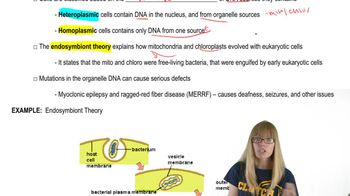Table of contents
- 1. Introduction to Genetics51m
- 2. Mendel's Laws of Inheritance3h 37m
- 3. Extensions to Mendelian Inheritance2h 41m
- 4. Genetic Mapping and Linkage2h 28m
- 5. Genetics of Bacteria and Viruses1h 21m
- 6. Chromosomal Variation1h 48m
- 7. DNA and Chromosome Structure56m
- 8. DNA Replication1h 10m
- 9. Mitosis and Meiosis1h 34m
- 10. Transcription1h 0m
- 11. Translation58m
- 12. Gene Regulation in Prokaryotes1h 19m
- 13. Gene Regulation in Eukaryotes44m
- 14. Genetic Control of Development44m
- 15. Genomes and Genomics1h 50m
- 16. Transposable Elements47m
- 17. Mutation, Repair, and Recombination1h 6m
- 18. Molecular Genetic Tools19m
- 19. Cancer Genetics29m
- 20. Quantitative Genetics1h 26m
- 21. Population Genetics50m
- 22. Evolutionary Genetics29m
3. Extensions to Mendelian Inheritance
Organelle DNA
Problem 17
Textbook Question
The first person in a family to exhibit Leber hereditary optic neuropathy (LHON) was II-3 in the pedigree shown below, and all of her children also exhibited the disease. Provide two possible explanations as to why II-3's mother (I-1) did not exhibit symptoms of LHON.

 Verified step by step guidance
Verified step by step guidance1
Identify that Leber hereditary optic neuropathy (LHON) is a mitochondrial disorder, which means it is passed through the maternal line.
Observe that individual II-3 is affected and all her children (III-1, III-2, III-3) are also affected, indicating maternal inheritance.
Consider that I-1, the mother of II-3, might not exhibit symptoms due to heteroplasmy, where a mixture of normal and mutated mitochondria exists, and the proportion of mutated mitochondria is not sufficient to cause symptoms.
Another possibility is that I-1 has a lower penetrance of the disease, meaning she carries the mutation but does not express the symptoms due to other genetic or environmental factors.
Conclude that the absence of symptoms in I-1 does not preclude her from being a carrier of the mitochondrial mutation responsible for LHON.
Recommended similar problem, with video answer:
 Verified Solution
Verified SolutionThis video solution was recommended by our tutors as helpful for the problem above
Video duration:
1mPlay a video:
Was this helpful?

 4:11m
4:11mWatch next
Master Organelle DNA Characteristics with a bite sized video explanation from Kylia Goodner
Start learningRelated Videos
Related Practice



